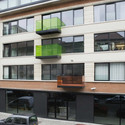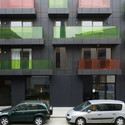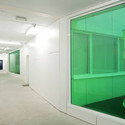
-
Architects: Lhoas & Lhoas Architectes
- Area: 9520 m²
- Year: 2010
-
Photographs:Maxime Delvaux @ 354 photographers
Text description provided by the architects. This 40 apartments building in downtown brussels was commissioned by a real estate developer. The building is part of an ensemble of 3 existing building with very different characteristics and is situated between 3 streets (Fabriques/Senne/Anneessens). The surrounding existing buildings are very motley, regarding heights, functions, typologies. The project proposed to enhance the neoclassical building in order to restore the urban order by joining the size of the building next door. This raise consists of a dark volume, reminder of the new building located at the opposite corner of the complex and of the central part enhances. The new parts are therefore designed with a specific expression of unification of the complex.

They are identified by the color black, while a series of elements (balconies, volumes, buildings) transplanted / reported, from different sizes, colors and scales, animate / complete / consolidate this portion of the hétéroclite building block. The new building forms a new relationship between the Rue de la Senne and the Anneessen sstreet, two streets of different status. It confirms an alignment character on the side of the Rue de la Senne and a more complex morphology on the Anneessens street, allowing to develop a court for the private art foundation -Vanhaerens Art Collection - located in the neighboring building. It is an articulated / dislocated ensemble, and a patella between these different levels. The relationship between the various buildings that make up the project and between the project and its environment is an update / modernization of the traditional urban system.

The diversity of this project must be included in a double meaning, namely a functional mix and mixed cluster. The functional mix offers a traditional division of functions in the non-residential ground floor of the complex. Lhoas Lhoas designed adaptive rooms, which can be used for office or retail space. The current occupation of the ground floor clearly confirms this versatility.

The mixed cluster lies in a systematic and enhancement of existing assets and the insertion of new parts that complement / articulate the existing. The advantage of mixing between old and new is a desire to offer the optimum ratio between, on the one hand, the quality and functionality of spaces and on the other hand, her recoverability, from the perspective of sustainable development.

The mixed cluster that is exploited in the project will provide very different housing in terms of spatiality, and promotes almost "natural" integration in dense urban fabric, which is undoubtedly one essential qualities of this project. This enhancement of the existing is in any way an identical renovation or restoration but the existing has to be considered as a given potential to generate new typologies and spaces for additions, subtraction, specific openings and articulations.

The creation of interior / exterior distribution may be mentioned. That helped to develop through - apartments, to increase the number and the variety, to significantly reduce stress fire safety and the number of vertical circulation and to allow systematic access to the covered parking of the building. This attitude is both respectful and unashamedly over the existing and finds expression in the transformation of the neo-classical building corner: what is preserved, is restored with great care, and the current functional requirements - such as the need to find outdoor spaces for dwellings - are satisfied, however drastically and equally treated, as shown in the corner terrace. This same attitude of valorization the existing can be illustrated by the treatment of the central building of the 50's. The openings bring a sense of space in the homes they illuminate, or the

"uninhibited" cuts of the existing bays, modified to provide outdoor spaces for the housing.





































